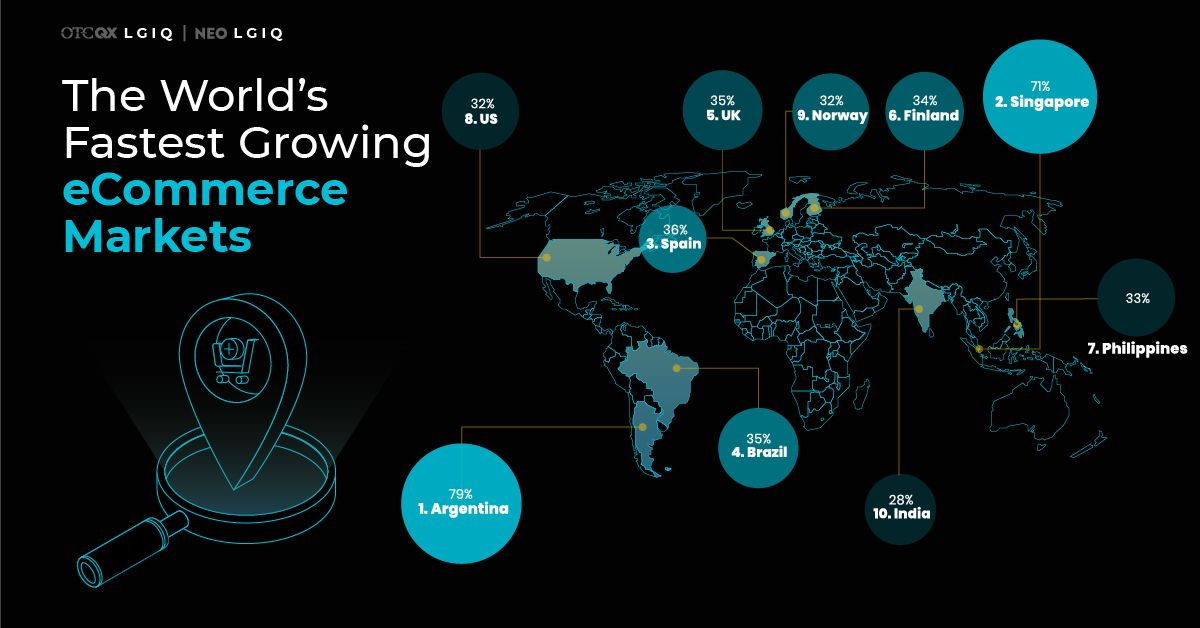Mapped: The World’s Fastest Growing eCommerce Markets
The following content is sponsored by Logiq

The World’s Fastest Growing eCommerce Markets
While the overall retail industry struggled amidst the global pandemic, eCommerce sales managed to reach unprecedented heights. In 2020, retail eCommerce sales grew by 27.6%, reaching a total of $4.28 trillion worldwide.
But which regions saw the biggest increases throughout 2020, and how does each market compare to one another? This graphic, presented by Logiq, explores the fastest growing eCommerce markets across the globe.
Which Markets Saw the Most Growth?
In 2020, Latin America’s eCommerce market saw the most growth of any region, surpassing Asia-Pacific’s growth for the first time since 2010.
| Rank | Region | Sales Growth YoY (2020) |
|---|---|---|
| 1 | Latin America | 36.7% |
| 2 | North America | 31.8% |
| 3 | Central & Eastern Europe | 29.1% |
| 4 | Asia-Pacific | 26.4% |
| 5 | Western Europe | 26.3% |
| 6 | Middle East & Africa | 19.8% |
| Worldwide Average | 27.6% |
The pandemic played a big role in Latin America’s growth. The region’s two major economic hubs Buenos Aires, Argentina and São Paulo, Brazil had to endure strict pandemic-induced lockdowns, which ultimately led to significant growth of the eCommerce market.
Restrictions in Buenos Aires were on and off from late March until early November 2020, and after restrictions were lifted, citizens were encouraged to practice “intelligent” social distancing and be more cautious when socializing.
At the country level, Argentina was the fastest growing eCommerce market in 2020, with a 79% increase in online sales compared to 2019—almost double the worldwide country average.
| Rank | Country | Sales Growth YoY (2020) |
|---|---|---|
| 1 | 🇦🇷 Argentina | 79.0% |
| 2 | 🇸🇬 Singapore | 71.1% |
| 3 | 🇪🇸 Spain | 36.0% |
| 4 | 🇧🇷 Brazil | 35.0% |
| 5 | 🇬🇧 UK | 34.7% |
| 6 | 🇫🇮 Finland | 33.5% |
| 7 | 🇵🇭 Philippines | 33.0% |
| 8 | 🇺🇸 US | 32.4% |
| 9 | 🇳🇴 Norway | 32.2% |
| 10 | 🇮🇳 India | 27.6% |
| Worldwide Average | 41.5% |
Singapore was the second-fastest, with a 71.1% increase in eCommerce sales.
Keen to capitalize on this rising trend, Singapore has rolled out a number of policies and initiatives in an effort to support its digital industry.
For example, under the Skills Ignition SG initiative, several Singaporean government agencies have partnered with Google to provide training for aspiring tech workers.
Third on the ranking is Spain with a 36% increase in eCommerce sales. Spain was severely impacted by COVID-19—in the early days of the pandemic, cases in Spain rose quickly, causing strain on the country’s healthcare system and ultimately driving the country into strict lockdown, which forced consumers to turn to online shopping.
eCommerce Growth, by Category
Though eCommerce sales in 2020 saw an overall increase, some industries saw more success than others. For instance, global spending on Food and Personal Care grew significantly (44.8%) in 2020, while Travel spending dipped more than 50%.
| Category | % Global change in spending (2019-2020) |
|---|---|
| Food & Personal Care | 44.8% |
| Electronics & Physical Media | 43.9% |
| Toys, DIY & Hobbies | 37.4% |
| Digital Music | 35.2% |
| Fashion & Beauty | 34.4% |
| Video Games | 32.8% |
| Furniture & Appliances | 30.9% |
| Travel, Mobility & Accommodation | -52.6% |
Of course, since travel is expected to bounce back by 2023, according to a recent report by the International Air Transport Association, these figures are likely to change in the near future.
Different Markets, Different Marketing
While eCommerce has grown worldwide, each individual market looks slightly different, which means generic marketing tactics won’t work across the board.
That’s why companies need eCommerce support that caters to their unique needs if they’re hoping to level up their eCommerce game. Logiq is a holistic eCommerce platform that provides versatile services, which can help companies worldwide.
In this rapidly growing space, Logiq helps businesses better understand their audience, gather insight into the techniques that best serve them and ultimately gain their rightful piece of the pie.
-

 Sponsored3 years ago
Sponsored3 years agoMore Than Precious: Silver’s Role in the New Energy Era (Part 3 of 3)
Long known as a precious metal, silver in solar and EV technologies will redefine its role and importance to a greener economy.
-

 Sponsored7 years ago
Sponsored7 years agoThe History and Evolution of the Video Games Market
Everything from Pong to the rise of mobile gaming and AR/VR. Learn about the $100 billion video games market in this giant infographic.
-

 Sponsored8 years ago
Sponsored8 years agoThe Extraordinary Raw Materials in an iPhone 6s
Over 700 million iPhones have now been sold, but the iPhone would not exist if it were not for the raw materials that make the technology...
-

 Sponsored8 years ago
Sponsored8 years agoThe Industrial Internet, and How It’s Revolutionizing Mining
The convergence of the global industrial sector with big data and the internet of things, or the Industrial Internet, will revolutionize how mining works.


